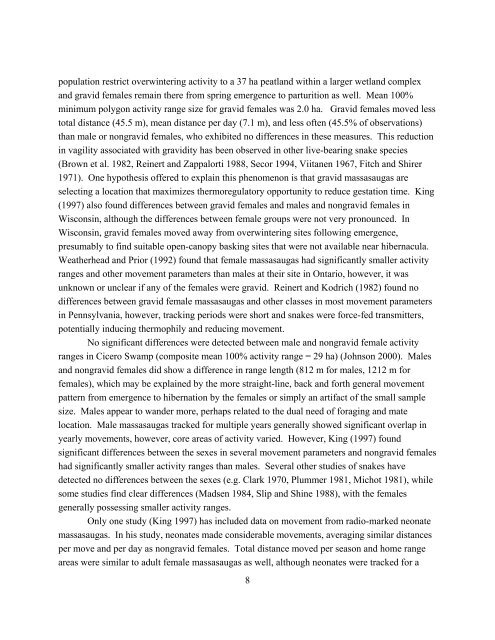The Eastern Massasauga Rattlesnake: - U.S. Fish and Wildlife Service
The Eastern Massasauga Rattlesnake: - U.S. Fish and Wildlife Service
The Eastern Massasauga Rattlesnake: - U.S. Fish and Wildlife Service
You also want an ePaper? Increase the reach of your titles
YUMPU automatically turns print PDFs into web optimized ePapers that Google loves.
population restrict overwintering activity to a 37 ha peatl<strong>and</strong> within a larger wetl<strong>and</strong> complex<br />
<strong>and</strong> gravid females remain there from spring emergence to parturition as well. Mean 100%<br />
minimum polygon activity range size for gravid females was 2.0 ha. Gravid females moved less<br />
total distance (45.5 m), mean distance per day (7.1 m), <strong>and</strong> less often (45.5% of observations)<br />
than male or nongravid females, who exhibited no differences in these measures. This reduction<br />
in vagility associated with gravidity has been observed in other live-bearing snake species<br />
(Brown et al. 1982, Reinert <strong>and</strong> Zappalorti 1988, Secor 1994, Viitanen 1967, Fitch <strong>and</strong> Shirer<br />
1971). One hypothesis offered to explain this phenomenon is that gravid massasaugas are<br />
selecting a location that maximizes thermoregulatory opportunity to reduce gestation time. King<br />
(1997) also found differences between gravid females <strong>and</strong> males <strong>and</strong> nongravid females in<br />
Wisconsin, although the differences between female groups were not very pronounced. In<br />
Wisconsin, gravid females moved away from overwintering sites following emergence,<br />
presumably to find suitable open-canopy basking sites that were not available near hibernacula.<br />
Weatherhead <strong>and</strong> Prior (1992) found that female massasaugas had significantly smaller activity<br />
ranges <strong>and</strong> other movement parameters than males at their site in Ontario, however, it was<br />
unknown or unclear if any of the females were gravid. Reinert <strong>and</strong> Kodrich (1982) found no<br />
differences between gravid female massasaugas <strong>and</strong> other classes in most movement parameters<br />
in Pennsylvania, however, tracking periods were short <strong>and</strong> snakes were force-fed transmitters,<br />
potentially inducing thermophily <strong>and</strong> reducing movement.<br />
No significant differences were detected between male <strong>and</strong> nongravid female activity<br />
ranges in Cicero Swamp (composite mean 100% activity range = 29 ha) (Johnson 2000). Males<br />
<strong>and</strong> nongravid females did show a difference in range length (812 m for males, 1212 m for<br />
females), which may be explained by the more straight-line, back <strong>and</strong> forth general movement<br />
pattern from emergence to hibernation by the females or simply an artifact of the small sample<br />
size. Males appear to w<strong>and</strong>er more, perhaps related to the dual need of foraging <strong>and</strong> mate<br />
location. Male massasaugas tracked for multiple years generally showed significant overlap in<br />
yearly movements, however, core areas of activity varied. However, King (1997) found<br />
significant differences between the sexes in several movement parameters <strong>and</strong> nongravid females<br />
had significantly smaller activity ranges than males. Several other studies of snakes have<br />
detected no differences between the sexes (e.g. Clark 1970, Plummer 1981, Michot 1981), while<br />
some studies find clear differences (Madsen 1984, Slip <strong>and</strong> Shine 1988), with the females<br />
generally possessing smaller activity ranges.<br />
Only one study (King 1997) has included data on movement from radio-marked neonate<br />
massasaugas. In his study, neonates made considerable movements, averaging similar distances<br />
per move <strong>and</strong> per day as nongravid females. Total distance moved per season <strong>and</strong> home range<br />
areas were similar to adult female massasaugas as well, although neonates were tracked for a<br />
8

















